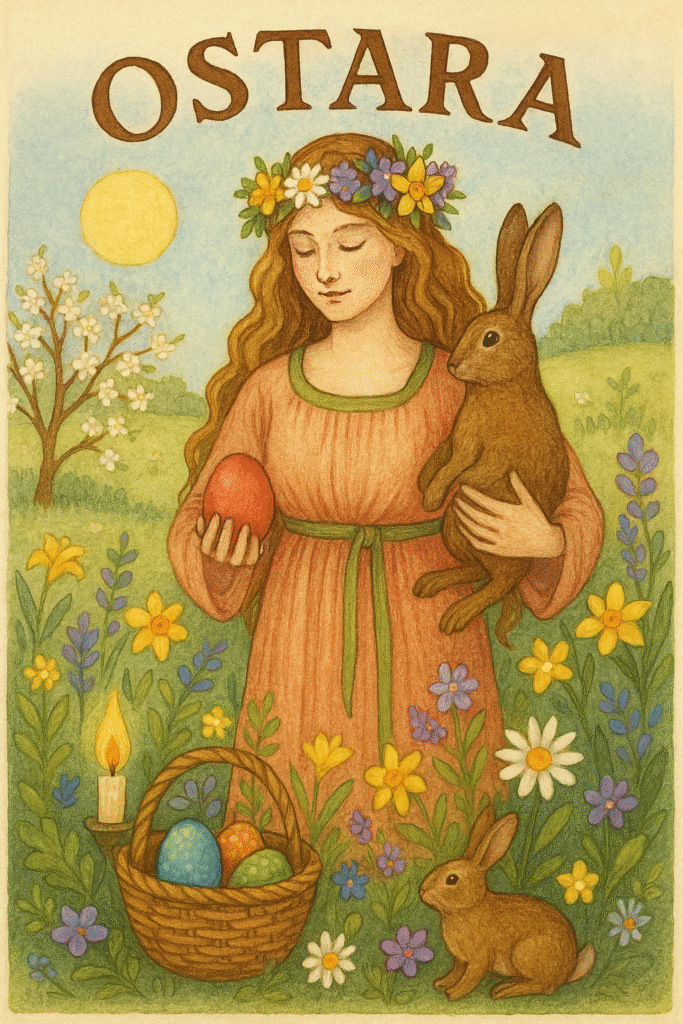
Ostara, celebrated around the Spring Equinox (circa 20–23 March in the Northern Hemisphere), marks a pivotal moment in the Wheel of the Year. Rooted in ancient Pagan and Germanic traditions, this festival honours the balance of light and dark, the fertility of the earth, and the promise of renewal. As day and night stand equal, Ostara invites reflection, celebration, and the planting of intentions—both literal and spiritual.
Historical Origins and Etymology
The name Ostara is believed to derive from the Germanic goddess Ēostre, referenced by the Anglo-Saxon monk Bede in the 8th century. He described April as Eosturmonath, a month named after the goddess associated with spring and fertility. While historical evidence of Ēostre’s worship is limited, her legacy endures in modern Pagan and Wiccan practice, and her name likely influenced the Christian term Easter.
The Spring Equinox itself was observed by various ancient cultures. The Celts, Norse, and Romans all marked seasonal transitions with rites honouring agricultural cycles, deities of fertility, and the turning of the sun. Ostara, as revived in contemporary Paganism, blends these influences into a celebration of rebirth and balance.
Folklore and Symbolism
Ostara is steeped in folkloric motifs that echo themes of fertility, awakening, and transformation:
- The Hare and the Egg: Central to Ostara lore is the myth of Ēostre transforming a bird into a hare, which then laid coloured eggs in her honour. This tale, though modern in origin, symbolises the merging of animal fertility and seasonal renewal. The hare, a lunar creature, represents abundance and intuitive energy, while the egg embodies potential and new life.
- The Vernal Goddess: Ēostre, or Ostara, is often depicted as a youthful maiden crowned with spring flowers, walking barefoot across thawing earth. She embodies innocence, growth, and the stirring of sensual and creative energies.
- Balance of Light and Dark: The equinox is a liminal time—neither winter nor summer. Folklore often frames this as a moment when opposing forces meet in harmony, allowing for personal and cosmic recalibration.
Traditional Celebrations and Rituals
Modern Pagan and Wiccan communities celebrate Ostara with rituals that honour the earth’s awakening and the balance of energies:
- Altar Decorations: Altars are adorned with spring flowers (daffodils, crocuses), pastel-coloured candles, eggs, and symbols of fertility such as hares and seeds.
- Egg Decorating: A practice adopted into secular Easter traditions, painting eggs at Ostara is a symbolic act of blessing and intention-setting. Each colour and design may represent a wish or affirmation.
- Seed Planting: Whether in gardens or pots, planting seeds during Ostara is both a literal and spiritual gesture—inviting growth, abundance, and manifestation.
- Balance Rituals: Some practitioners perform meditations or spellwork focused on restoring equilibrium in relationships, health, or personal goals.
- Feasting: Seasonal foods such as leafy greens, dairy, honey, and early spring vegetables are shared in communal meals, often outdoors to honour the returning sun.
Gifts and Offerings
Ostara gifts reflect the themes of fertility, creativity, and renewal. Popular offerings include:
- Crystal Sets: Stones like moss agate, rose quartz, and citrine are favoured for their alignment with growth, love, and solar energy.
- Herbal Bundles: Spring herbs such as lavender, thyme, and lemon balm are bundled for cleansing and blessing rituals.
- Handcrafted Eggs: Wooden or ceramic eggs painted with runes, floral motifs, or affirmations serve as keepsakes and altar pieces.
- Seasonal Candles: Scented with florals or fresh herbs, candles in pastel hues evoke the light and warmth of spring.
- Goddess Figurines: Representations of Ostara or other vernal deities are gifted to honour feminine energy and the cycle of rebirth.
Conclusion
Ostara is more than a seasonal marker—it is a spiritual invitation to awaken, balance, and bloom. Through its rich tapestry of folklore, ritual, and symbolism, the festival offers a moment to honour the earth’s rhythms and our place within them. Whether through quiet reflection or joyful celebration, Ostara reminds us that renewal is always possible, and that the seeds we plant—literal or metaphorical—hold the promise of transformation.
